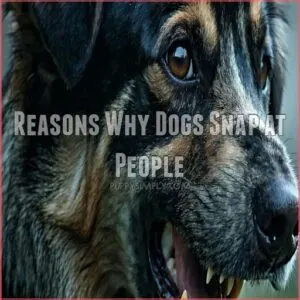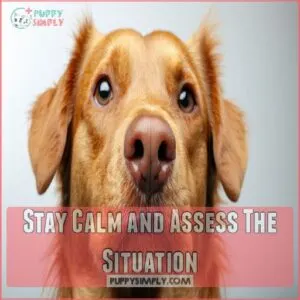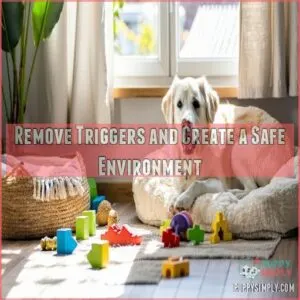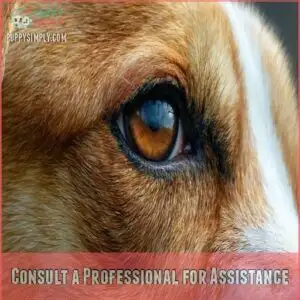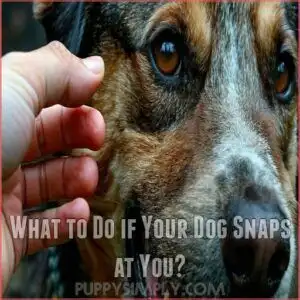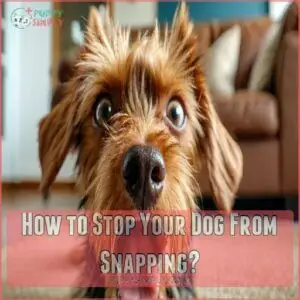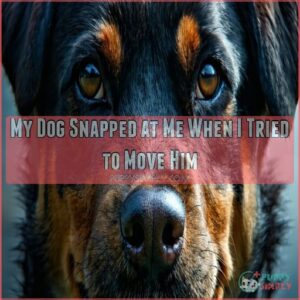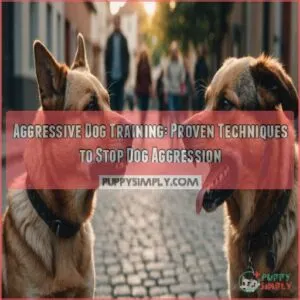This site is supported by our readers. We may earn a commission, at no cost to you, if you purchase through links.
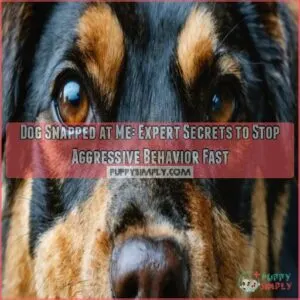 If your dog snapped at you, it’s a clear sign something’s wrong, but don’t panic.
If your dog snapped at you, it’s a clear sign something’s wrong, but don’t panic.
Dogs snap for reasons like pain, fear, or feeling startled. Sometimes it’s about protecting food, toys, or their space.
Start by observing your dog’s body language—stiffness, whale eyes, or growling can signal discomfort. Avoid punishment; instead, calmly assess the situation and remove any triggers.
It helps to work with a vet to rule out pain and a behavior expert to address deeper issues. Understanding your pup’s cues and building trust is key.
Curious about how to manage snapping long-term? Stick around to learn actionable strategies.
Table Of Contents
- Key Takeaways
- Reasons Why Dogs Snap at People
- How to React When Your Dog Snaps at You
- What to Do if Your Dog Snaps at You?
- How to Stop Your Dog From Snapping?
- Should You Punish a Dog for Snapping?
- My Dog Snaps at Me When I Pet Him
- My Dog Snapped at Me When I Tried to Move Him
- Frequently Asked Questions (FAQs)
- Why does my dog snap?
- What happens if a dog snaps at you?
- Should you punish a dog for snapping?
- What if my dog snapped at me for the first time?
- How to stop a dog from snapping?
- What to do if a dog snaps at you?
- What should you do if your dog snaps at you?
- Why would a dog snap at its owner?
- Why is my dog snapping at me all of a sudden?
- Why is my dog snapping at me when I pet her?
- Conclusion
Key Takeaways
- Stay calm and observe your dog’s body language to identify triggers behind snapping, such as fear, pain, or discomfort.
- Avoid punishment, as it can increase fear and aggression; focus on positive reinforcement instead.
- Work with a veterinarian to rule out pain and consult a behaviorist if the snapping persists or escalates.
- Respect your dog’s boundaries, create safe spaces, and use gradual desensitization for touch- or movement-related issues.
Reasons Why Dogs Snap at People
When your dog snaps at you, it’s a critical communication signal that something’s wrong.
Understanding the root causes of this behavior can help you prevent future incidents and rebuild trust with your furry companion.
Pain
A sharp yelp or sudden snap could be your dog’s desperate signal of hidden pain. When dogs experience discomfort, they often communicate through defensive behaviors that catch owners off guard. Understanding pain sources is key for maintaining your pet’s well-being and preventing aggressive incidents.
Here are key pain indicators to watch for:
- Sudden changes in mobility or reluctance to move
- Whimpering or tensing when touched in specific areas
- Unexplained aggression or irritability during physical contact
Pain management requires careful observation and professional guidance. Veterinarians can help identify underlying medical conditions like arthritis, injuries, or internal issues that might trigger your dog’s snapping behavior. By recognizing these warning signs early, you’ll protect both your dog’s health and your relationship, transforming potential conflict into compassionate care.
Fear
Fear can transform a loving companion into a reactive bundle of nerves. When your dog snaps out of fear, it’s a critical communication signal you can’t afford to ignore.
Here are 10 key insights about fear-based dog snapping:
- Fear triggers can stem from past trauma or sudden environmental changes
- Dogs communicate fear through body language before snapping
- Stiffening, crouching, and whale eye are warning signs
- Unexpected movements can startle and provoke defensive reactions
- Previous traumatic experiences substantially impact fear responses
- Loud noises, unfamiliar people, or sudden touches may cause fear
- Dogs need a safe personal space to feel secure
- Consistent, calm interactions help rebuild trust
- Professional behavioral training can address deep-rooted fears
- Understanding your dog’s individual fear triggers is vital
Managing your dog’s fear requires patience, observation, and gentle reassurance. Identify what sparks their anxiety and create a supportive environment that helps them feel protected. By recognizing fear as a communication tool, you’ll transform potential aggression into an opportunity for deeper understanding and connection.
Food Aggression
If you’ve ever felt the sharp warning of a dog’s snap during mealtime, you’re witnessing food aggression in action.
Food guarding triggers can turn your furry friend from cuddly companion to defensive protector faster than you can say "dinner’s ready."
Dogs develop this behavior for various reasons, from past scarcity to deep-seated insecurity about their resources.
Preventing food aggression starts with understanding why your pup feels the need to guard their kibble.
Puppy or adult, these aggressive moments aren’t just about the food—they’re a cry for help, signaling underlying anxiety or past experiences.
By recognizing these signs early, you can help your dog feel safer and more secure during mealtime.
Identifying common food aggression signs can also help you develop a plan to address this behavior.
Territorial Behavior
Something triggers your dog’s territorial aggression, turning them into a defensive guardian of their perceived space.
Territorial behavior often emerges when dogs feel their safe spaces are threatened by unfamiliar people or animals.
Watch for subtle calming signals that indicate your pup’s discomfort before snapping occurs.
Boundary training becomes essential in managing dog territorial behavior, helping your furry friend understand acceptable limits.
Identifying the root cause of such behavior is also key for customized training, which may involve positive reinforcement techniques.
Professional trainers can guide you through techniques that reduce aggressive responses in dog parks and home environments.
By understanding and addressing these territorial instincts, you’ll create a more confident, secure companion that feels less need to guard their domain aggressively.
Possessiveness
Territorial boundaries often expand to possessive behaviors that make your dog snap faster than a rubber band. Resource guarding isn’t just about protecting food—it’s a complex communication strategy your pup uses to feel secure. Dogs may even exhibit resource guarding over trash or other seemingly worthless items, as valued possessions can vary widely.
Here’s what you need to know about toy guarding and food aggression:
- Recognize warning signs like growling near prized possessions
- Understand possessive behaviors stem from deep-rooted survival instincts
- Learn to approach your dog’s treasured items with calm, predictable movements
- Never punish resource guarding; instead, build trust through positive reinforcement
Preventing possessiveness requires patience. By respecting your dog’s emotional landscape and teaching gentle boundaries, you’ll transform potential aggressive moments into opportunities for deeper connection.
How to React When Your Dog Snaps at You
When your dog snaps at you, it’s vital to stay calm and avoid sudden movements that might escalate the situation.
Your immediate response involves evaluating the environment, identifying potential triggers, and creating a safe space for both you and your dog.
Stay Calm and Assess The Situation
A heart-pounding dog-snapping moment demands a cool-headed response. When your furry friend shows teeth, pause and breathe deeply. Your calm reaction can prevent escalation and provide key insights. Recognizing triggers for aggressive behavior can be aided by the use of positive reinforcement dog training tools.
| Emotional State | Recommended Action |
|---|---|
| Shock | Stay still |
| Fear | Avoid direct eye contact |
| Anger | Control impulses |
| Confusion | Observe body language |
| Worry | Seek professional guidance |
Gather information about the incident without judgment, focusing on understanding your dog’s communication.
Remove Triggers and Create a Safe Environment
After staying calm during your dog’s snapping episode, it’s time to create a safe environment by removing potential triggers.
Start by identifying specific situations that provoke aggressive behavior. Map out your dog’s safe spaces and limit exposure to stressful stimuli.
Use dog-friendly toys that redirect attention and provide mental stimulation. Rearranging your home to minimize confrontational interactions can also help, as creating clear boundaries supports your pup’s emotional well-being by reducing fear-based aggression.
Gradually introduce calming techniques like quiet zones and predictable routines. Watch for warning signs like tense body language or subtle growls.
Proactively adjust your environment to reduce potential aggressive triggers, transforming your space into a peaceful sanctuary that supports your dog’s emotional well-being.
Consult a Professional for Assistance
When your dog’s snapping becomes a persistent concern, seeking professional help can be a game-changer. Dog behavior specialists offer expert advice to unravel the mysteries behind aggressive behaviors and provide targeted solutions.
- Identify hidden triggers causing your dog’s aggressive responses
- Develop personalized training strategies adapted to your dog’s specific needs
- Access professional guidance for safe behavioral modification
A certified behaviorist or qualified dog trainer can decode your pet’s complex communication signals and create a thorough intervention plan. They’ll help you understand whether the snapping stems from fear, pain, or territorial instincts.
In emergency situations involving dog aggression, these experts become your lifeline, offering scientific insights and practical techniques to rebuild trust and safety. Don’t let dog bite escalate – professional help transforms challenging behaviors into opportunities for deeper understanding and connection. They can also help you recognize and address underlying issues, such as a weak pack leadership or an underlying medical condition, that may be contributing to your dog’s snapping underlying canine behavior.
What to Do if Your Dog Snaps at You?
When your dog snaps at you, it’s a critical moment that demands your immediate, calm attention.
By understanding the underlying cause and responding strategically, you can prevent future incidents.
and restore trust with your furry companion.
Document Details and Identify Patterns
Staying calm after your dog snaps is just the beginning.
Your next move? Start a detailed behavior log.
Jot down snap triggers, time of day, who was present, and what led up to the incident. Track details like food proximity, touch location, and your dog’s body language.
These insights are gold for understanding why your furry friend might be feeling defensive or uncomfortable. Your observations could reveal hidden patterns that point to a solution. Understanding your dog’s behavior is key. Detailed behavior log is important.
Consult a Veterinarian for Behavior Evaluation
Taking detailed notes about your dog’s behavior sets the stage for a productive vet visit.
Schedule an appointment to rule out medical causes behind the snapping. Your veterinarian will conduct a thorough evaluation, checking for underlying illness that might trigger aggressive responses.
Professional can unpack whether your dog’s behavior stems from pain, anxiety, or other health concerns. A thorough medical assessment gives you the roadmap for understanding and addressing your dog’s unexpected snapping.
You can also consider seeking the expertise of a veterinary behavior service, such as the UC Davis Behavior Service, for a full behavioral evaluation.
Isolate Triggers and Find Solutions
In the midst of dog snapping incidents, methodically dissect the root causes by becoming a detective of your dog’s behavior.
Carefully observe and document specific scenarios that trigger aggressive responses, whether it’s territorial guarding, resource possession, or unexpected touch points.
Understanding canine body language, such as signs of stress or fear, is vital for effective dog aggression training, as it helps predict and manage potential aggressive behaviors.
Map out these trigger patterns to develop targeted solution strategies.
Look beyond surface-level reactions and dig deeper into understanding what makes your furry friend feel threatened or uncomfortable.
Professional behavior analysis can help unravel complex behavioral mysteries and provide customized intervention techniques.
Reward Non-Snapping Behavior
After pinpointing your dog’s triggers, it’s time to transform negative behavior through reward systems. When your furry friend remains calm and doesn’t snap, shower them with praise, treats, and attention. This positive reinforcement helps rewire their brain, teaching them that peaceful interactions earn amazing rewards.
By understanding canine body language, you can better recognize the signs of potential aggression and address them promptly.
- Treat Timing: Reward immediately after good behavior
- Consistency Matters: Use the same praise and reward method
- Variety is Key: Mix up rewards keep training engaging
Your dog will start connecting non-aggressive responses with positive experiences. Gradually, they’ll learn that staying calm brings more joy than snapping. Remember, patience and consistent positive reinforcement can turn even the most reactive pup into a well-adjusted companion.
How to Stop Your Dog From Snapping?
If your dog’s snapping behavior is causing stress and concern, you’re not alone in this challenging situation.
Understanding the root causes and implementing targeted strategies can help you effectively stop your dog from snapping.
restore a peaceful relationship.
Address Underlying Discomfort or Pain
When your dog snaps, it might signal hidden pain lurking beneath the surface. Pain management is vital in understanding and resolving aggressive behaviors. Identifying discomfort early can prevent further incidents and protect both you and your furry friend.
| Pain Trigger | Potential Solution | Urgency Level |
|---|---|---|
| Joint Stiffness | Canine Massage | High |
| Dental Issues | Vet Checkup | Critical |
| Muscle Strain | Joint Supplements | Medium |
| Hidden Injuries | Professional Exam | High |
| Age-Related Pain | Targeted Treatment | Medium |
Proper Socialization and Training
Consistently invest in early socialization to transform your dog’s behavior and prevent aggressive tendencies.
Professional puppy classes offer invaluable opportunities to develop essential social skills and communication:
- Build confidence through controlled interactions
- Learn proper canine communication
- Expose your dog to diverse environments
- Practice positive social experiences
- Develop trust and emotional regulation
Consistent training helps dogs navigate complex social situations, reducing the likelihood of snapping and promoting harmonious relationships.
Positive Reinforcement Techniques
Building on effective socialization, positive reinforcement transforms your dog’s snapping behavior through strategic planning.
Clicker training helps shape good responses, using treat motivation to build trust. Reward your pup instantly when they remain calm, reinforcing non-aggressive behaviors.
Short, specific commands paired with immediate treats create powerful associations that help your dog understand exactly what you want.
Identifying underlying causes like fear-based aggression is essential to develop a customized approach to address aggressive behavior.
Seek Professional Help if Needed
If your positive reinforcement efforts haven’t calmed your dog’s snapping, professional intervention becomes your best strategy.
Certified behaviorists can pinpoint complex triggers like territoriality, food aggression, or hidden pain that you might miss.
Professional dog trainers offer customized solutions beyond generic advice, helping you understand your pup’s unique communication signals.
Online resources and veterinary behaviorists provide thorough assessments to prevent potential dog bite incidents.
Don’t wait until snapping escalates – expert guidance can transform your relationship and restore household harmony.
Should You Punish a Dog for Snapping?
Punishing your dog for snapping can actually make the aggressive behavior worse, creating more fear and anxiety.
Instead, focus on understanding why your dog snapped and use positive reinforcement techniques to address the underlying cause.
Understanding The Purpose of Dog Snapping
After mastering dog training techniques, understanding why your furry friend snaps becomes paramount. Think of snapping as your dog’s way of speaking—a warning signal, not an attack.
Dog communication reveals complex emotions through body language and stress triggers.
- Snapping signals discomfort or fear
- Dogs communicate boundaries through warning signs
- Each snap carries a unique message
- Body language reveals underlying emotional states
Recognize these signals to prevent escalation and build trust.
Punishment Vs. Correction
The psychology behind dog snapping reveals a critical choice between punishment and correction. Your approach can make or break your relationship with your four-legged friend.
| Punishment | Correction | Result |
|---|---|---|
| Creates fear | Builds trust | Behavior change |
| Increases aggression | Reduces anxiety | Positive learning |
| Breaks connection | Strengthens bond | Mutual understanding |
Negative punishment often backfires, triggering more aggressive responses and eroding your dog’s confidence.
Instead, focus on humane training techniques that address the root cause of snapping. Effective correction means understanding your dog’s communication, identifying triggers, and using positive reinforcement to guide their behavior.
Remember, your goal is building a safe, trusting relationship through compassionate training methods. By understanding canine body language and subtle cues, you can prevent triggers and avoid aggression, such as fear-based aggression.
Focus on Positive Reinforcement
Compassion emerges as the cornerstone of effective dog training when addressing snapping behavior.
Instead of punishing your pup, focus on positive reinforcement methods that reward good behavior. Catch your dog being calm and praise them lavishly – treats, gentle pets, and excited voices work wonders.
Consistency is key in dog training, so everyone in the household must follow the same approach. When your dog avoids snapping, immediately reinforce that behavior with something they love. This builds trust and helps your furry friend understand exactly what you want.
Professional trainers can provide personalized strategies for addressing aggressive dog behaviors, especially if the snapping stems from deeper issues like fear or anxiety.
Remember, your goal is communication, not confrontation.
My Dog Snaps at Me When I Pet Him
If your dog snaps when you try to pet him, it’s a clear sign something’s wrong and he’s communicating discomfort or distress.
Understanding your dog’s body language and identifying potential triggers can help you address this behavior and restore trust between you and your furry companion.
Assessing The Trigger and Body Language
Beyond a raised hackle, your dog’s body language screams volumes about potential snapping triggers. Decoding these silent signals can prevent future conflicts.
Here’s what to watch:
- Ear position revealing emotional state
- Tail tension indicating discomfort
- Whale eye signaling potential aggression
By understanding these subtle cues, you’ll become fluent in your dog’s unspoken communication, transforming potential confrontations into moments of mutual understanding.
Gradual Desensitization and Counterconditioning
Learning to read your dog’s body language sets the stage for gradual desensitization techniques.
When your furry friend shows discomfort, you’ll want to slowly expose them to triggering situations in a controlled, safe environment.
Counterconditioning methods work like magic – pairing potentially stressful experiences with positive rewards. Think of it as rewiring your dog’s emotional response, one treat at a time.
Start small. If petting triggers anxiety, begin with brief, gentle touches followed immediately by high-value treats. Slowly increase contact time as your dog becomes more comfortable. Watch for subtle signs of relaxation – a soft ear, a calm tail, a relaxed body. These are your green lights to continue.
Patience is your secret weapon. Behavior modification isn’t an overnight fix, but a journey of understanding and rebuilding trust between you and your four-legged companion.
Seek Professional Behaviorist’s Advice
When gradual desensitization doesn’t fully resolve your dog’s snapping, it’s time to call in a professional behaviorist. These experts specialize in unpacking complex canine behaviors and creating personalized training strategies. Think of them as dog whisperers who can translate your pup’s hidden communication patterns.
Finding the right behaviorist involves some homework. Start by checking credentials and reading client reviews. Look for certified professionals with experience in aggression and snapping behaviors. A good behaviorist will conduct an in-depth assessment, observing your dog’s triggers and body language.
During your first session, be prepared to share detailed information about incidents, your dog’s history, and daily routines. Expect a cost between $100-$300 per consultation, though prices vary by location and specialist expertise. Most behaviorists offer follow-up support and customized training plans to help you and your dog build a safer, more trusting relationship.
Your investment now could prevent future aggressive incidents and strengthen your bond.
My Dog Snapped at Me When I Tried to Move Him
When your dog snaps at you while being moved, it’s a clear sign they’re feeling uncomfortable or defensive about their personal space.
Understanding the reasons behind this behavior is vital for creating a safer, more trusting relationship with your furry companion.
Respect Boundaries and Personal Space
Dogs often snap as a last-resort communication about uncomfortable boundaries. Your pup’s personal space is sacred territory that demands respect and understanding. Teaching your dog to back off commands can be an effective way to establish a safe distance.
- Recognize warning signals before they escalate
- Never force physical interaction
- Read subtle language cues
- Create safe zones in your home
- Practice consent-based interactions
Respecting your dog’s personal space isn’t about submission—it’s about building trust. When you approach calmly and let your dog initiate contact, you’re showing them you understand their emotional needs. Dogs have unique comfort levels, and pushing past those boundaries can trigger defensive behaviors like snapping. By establishing a calm approach and acknowledging their need for space, you’ll create a safer, more harmonious relationship that prevents potential aggressive incidents.
Training Commands for Cooperation
Respect for personal space goes hand-in-hand with teaching cooperative commands that keep both you and your pup safe.
Basic obedience training becomes your secret weapon against dog reactivity. Start with simple cue words like ‘sit,’ ‘stay,’ and ‘move’ to establish clear communication.
Positive reinforcement works magic – reward your dog with treats and praise when they follow hand signals, creating a positive association with movement commands.
Patience training helps build trust, showing your furry friend that listening brings good things. Each successful command reduces the likelihood of aggressive behavior, transforming potential tension into a moment of connection.
Practice these commands in calm environments first, gradually introducing more challenging scenarios. Remember, consistency is your best friend. Your dog wants to understand you, and clear, gentle guidance helps them feel secure and cooperative.
Gradual Acclimation to Being Moved
A light touch of patience can transform a tense situation when moving your furry friend.
Start by creating a comfortable environment that feels safe and predictable. Use gentle, slow progressions when you need to relocate your dog, breaking down the movement into small, manageable steps.
Positive reinforcement is your secret weapon – reward calm behavior with treats and soft praise.
Practice picking up or moving your dog in short, controlled sessions, always watching for signs of stress or discomfort.
If your dog shows signs of anxiety during dog snapping situations, take a step back and move more slowly. Gentle handling and consistent training can help reduce dog reactivity.
Remember, each small success builds trust and helps your dog feel more secure during uncomfortable moments. Professional guidance can provide additional support if needed.
Frequently Asked Questions (FAQs)
Why does my dog snap?
Nearly 20% of dog owners report snapping incidents.
Your dog might snap out of fear, pain, or protecting resources.
Pay attention to triggers, stay calm, avoid punishment, and seek professional help if snapping continues or escalates.
What happens if a dog snaps at you?
If a dog snaps at you, it’s a warning sign.
Stay calm, don’t punish them, and back off to avoid escalating the situation.
Assess triggers, make certain of safety, and consider professional help for behavior management.
Should you punish a dog for snapping?
Punishing a dog for snapping is like pouring gas on a fire—it worsens fear and aggression.
Stay calm, back off, and assess triggers.
Use positive reinforcement to rebuild trust and address underlying causes effectively.
What if my dog snapped at me for the first time?
Take a deep breath and stay calm.
Your dog’s snap might signal fear, pain, or discomfort.
Step back, assess what triggered it, and avoid punishment.
If it happens again, consult a trainer or vet.
How to stop a dog from snapping?
Think of snapping as your dog’s smoke alarm—warning, not aggression.
Stay calm, identify triggers, and avoid punishment.
Use positive reinforcement, set clear boundaries, respect their space, and consult a trainer or vet if needed.
What to do if a dog snaps at you?
Stay calm, step back, and give the dog space.
Don’t scold or react negatively.
Observe what triggered the snap.
If it continues, consult a trainer or vet to address behavior or potential health issues.
What should you do if your dog snaps at you?
If your dog snaps at you, remain calm and assess the situation to identify triggers.
Back off, giving space.
Consult a professional if needed, as punishment can worsen anxiety and aggression.
Why would a dog snap at its owner?
Your dog might snap due to fear, pain, feeling threatened, or protecting resources like food or toys.
It can also signal discomfort or overstimulation.
Understanding their triggers helps you respond calmly and prevent future incidents.
Why is my dog snapping at me all of a sudden?
Imagine your dog snapping like a sudden thunderclap—it’s likely fear, pain, or feeling cornered.
Dogs don’t snap randomly.
Check for triggers, illness, or stressors. Stay calm, reassess, and consider professional help if it persists.
Why is my dog snapping at me when I pet her?
Snapping when petted often stems from pain or discomfort.
Check for underlying medical issues, such as arthritis or skin problems.
Adjust your touch to avoid sensitive areas to help your dog feel more at ease.
Conclusion
When your dog snapped at you, it was likely their way of waving a red flag, signaling discomfort or distress.
By staying calm, identifying triggers, and focusing on building trust, you can address the behavior effectively.
Work with a vet or behaviorist to rule out pain and guide proper training techniques.
Reward positive behavior and avoid punishment—it only fuels fear.
With patience and consistency, you’ll help your dog feel secure, creating a stronger bond and lasting positive change.

